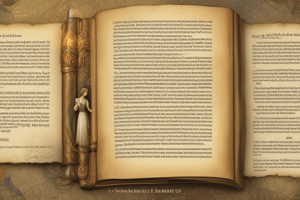Podcast
Questions and Answers
Non-literary texts are primarily intended to inform, persuade, or ______ an audience.
Non-literary texts are primarily intended to inform, persuade, or ______ an audience.
entertain
Texts that aim to clarify or explain concepts, such as instructional guides and legal texts, are considered ______.
Texts that aim to clarify or explain concepts, such as instructional guides and legal texts, are considered ______.
explanatory
A well-organized structure in non-literary texts enhances ______ and understanding for the reader.
A well-organized structure in non-literary texts enhances ______ and understanding for the reader.
clarity
[Blank] and sub______ break the text into manageable parts to guide the reader.
[Blank] and sub______ break the text into manageable parts to guide the reader.
Non-literary texts use a ______ progression to ensure easy comprehension.
Non-literary texts use a ______ progression to ensure easy comprehension.
The use of facts, statistics, and evidence allow non-literary texts to ______ claims.
The use of facts, statistics, and evidence allow non-literary texts to ______ claims.
Objectivity in news reporting is achieved through a ______ tone.
Objectivity in news reporting is achieved through a ______ tone.
Clarity and ______ in non-literary texts ensure easy understanding.
Clarity and ______ in non-literary texts ensure easy understanding.
Technical language or jargon is used in non-literary texts specific to a particular ______ or subject.
Technical language or jargon is used in non-literary texts specific to a particular ______ or subject.
[Blank] language is typically found in user manuals, whereas others are more specialized.
[Blank] language is typically found in user manuals, whereas others are more specialized.
Citing facts and statistics builds ______ through logical reasoning.
Citing facts and statistics builds ______ through logical reasoning.
Evidence and support provide factual ______ for arguments.
Evidence and support provide factual ______ for arguments.
Non-literary texts are written with a specific ______ in mind.
Non-literary texts are written with a specific ______ in mind.
The language, tone, and style reflect the audience's needs and ______.
The language, tone, and style reflect the audience's needs and ______.
A legal document may call for a specific legal ______.
A legal document may call for a specific legal ______.
Non-literary texts may include a direct or implicit ______ to action.
Non-literary texts may include a direct or implicit ______ to action.
Images, graphs, and charts complement written content as examples of ______ of visuals.
Images, graphs, and charts complement written content as examples of ______ of visuals.
Bullet points, lists, and bold text make information more digestible as examples of ______ elements.
Bullet points, lists, and bold text make information more digestible as examples of ______ elements.
The primary function of non-literary texts involves ______ and efficiency.
The primary function of non-literary texts involves ______ and efficiency.
A specific, practical ______ is the aim of non-literary texts.
A specific, practical ______ is the aim of non-literary texts.
Flashcards
Non-Literary Texts
Non-Literary Texts
Written or spoken works intended to inform, persuade, or entertain, serving functional, practical purposes in contexts like journalism and advertising.
Informative Texts
Informative Texts
Non-literary texts designed to inform the audience, commonly seen in news articles, research papers, and manuals.
Persuasive Texts
Persuasive Texts
Non-literary texts that aim to influence or persuade the audience, such as advertisements, political speeches, and opinion pieces.
Explanatory Texts
Explanatory Texts
Signup and view all the flashcards
Clear Structure
Clear Structure
Signup and view all the flashcards
Headings and Subheadings
Headings and Subheadings
Signup and view all the flashcards
Logical Progression
Logical Progression
Signup and view all the flashcards
Focus on Facts
Focus on Facts
Signup and view all the flashcards
Neutral Tone
Neutral Tone
Signup and view all the flashcards
Clarity and Precision
Clarity and Precision
Signup and view all the flashcards
Field-Specific Terminology
Field-Specific Terminology
Signup and view all the flashcards
Rhetorical Strategies in Non-Literary Texts
Rhetorical Strategies in Non-Literary Texts
Signup and view all the flashcards
Evidence and Support
Evidence and Support
Signup and view all the flashcards
Audience-Oriented Non-Literary Text
Audience-Oriented Non-Literary Text
Signup and view all the flashcards
Contextual Influence
Contextual Influence
Signup and view all the flashcards
Action-Oriented Texts
Action-Oriented Texts
Signup and view all the flashcards
Clear Call to Action
Clear Call to Action
Signup and view all the flashcards
Visual Elements
Visual Elements
Signup and view all the flashcards
Design Elements
Design Elements
Signup and view all the flashcards
Usefulness and Efficiency
Usefulness and Efficiency
Signup and view all the flashcards
Study Notes
- Non-literary texts are written or spoken to inform, persuade, or entertain, rather than to tell a story or explore complex emotions as literary texts do.
- They serve functional, practical purposes and are often found in journalism, advertising, academic writing, and legal documents.
Purpose-driven
- Non-literary texts are often designed to inform the audience, such as news articles, research papers, or manuals.
- Aim to influence or persuade the audience, like advertisements, political speeches, or opinion pieces.
- Some texts aim to clarify or explain concepts, such as instructional guides, legal texts, or technical reports.
Structured and Organized
- Non-literary texts usually have a well-organized structure that aids in clarity and understanding.
- A report might have sections like an introduction, methods, results, and conclusion.
- Headings and subheadings help break the text into manageable parts and guide the reader through the information.
- Non-literary texts tend to follow a logical order to ensure easy comprehension.
- An article might start with an introduction and end with a conclusion or call to action.
Objective and Fact-based
- Non-literary texts often rely on facts, statistics, and evidence to support claims, especially in academic, scientific, and journalistic genres.
- While non-literary texts can be persuasive, they typically aim for objectivity.
- The goal is to communicate information in a clear and unbiased manner, especially in news reporting or technical writing.
- Favor clear, concise language to avoid confusion and ensure that the message is easily understood.
Use of Specialized Language and Jargon
- Many non-literary texts use technical language or jargon specific to a particular field or subject (e.g., scientific reports, legal texts, or medical documents).
- While some non-literary texts (like user manuals or general news articles) use plain language, others (like academic articles or law texts) may use more specialized language.
Appeal to Logic (Logos)
- Non-literary texts often use logical reasoning to persuade the reader.
- This includes citing facts, statistics, expert opinions, or logical arguments to build credibility.
- The language used in these texts often provides factual backing for arguments or information to strengthen the persuasive or informative nature of the text.
External Context and Audience Awareness
- Non-literary texts are often written with a specific audience in mind, and the language, tone, and style will reflect this audience's needs and expectations.
- Examples of language adjustment based on the audience include technical language for professionals and simpler language for the general public.
- The context in which the text appears (e.g., political, commercial, academic) significantly shapes its language and tone.
- Product description example: may use emotive language to appeal to consumers.
- Scientific article example: will focus on neutrality and objectivity.
Purpose of Communication
- Many non-literary texts are written to prompt action or decision-making.
- A legal document may call for a specific legal action.
- An advertisement may encourage a consumer to buy a product.
- Include a direct or implicit call to action, such as urging readers to make a purchase, change their opinion, or engage with the content further.
Visual Elements
- Non-literary texts often use images, graphs, charts, tables, or other visual elements to complement the written content.
- A business report might include graphs to illustrate statistical data.
- Design elements may also be involved like bullet points, lists, or bold text to make information more digestible and emphasize key points.
Functionality and Practicality
- The primary function of non-literary texts is often practical, to solve a problem, deliver news, explain a process, or facilitate communication in a professional or commercial context.
- This is distinct from literary texts, which are more about artistic expression and exploration of human experiences.
- Aim for a specific practical outcome, such as explaining how to assemble a product, providing instructions for a process, or informing an audience of current events.
Examples of Non-Literary Texts:
- News Articles: Present facts, analysis, and opinions about current events.
- Advertisements: Persuasive texts designed to sell a product or service.
- Technical Manuals: Instructional texts with specific language and purpose to guide the user through a process.
- Research Papers: Scholarly articles that present new findings, data, and analyses.
- Legal Documents: Contracts, policies, and other documents that require precise language to ensure clarity and enforceability.
- Speeches: Often persuasive or informative, with an emphasis on audience engagement.
- Instructional Guides: Texts that provide step-by-step information or directions for a task.
Importance of Language
- The importance of language in non-literary texts cannot be overstated, as it directly influences how effectively the text communicates its intended message, persuades its audience, and achieves its purpose.
- Non-literary texts, such as news articles, advertisements, legal documents, reports, and manuals, are designed to inform, persuade, explain, or instruct, and language plays a central role in each of these functions.
Studying That Suits You
Use AI to generate personalized quizzes and flashcards to suit your learning preferences.




